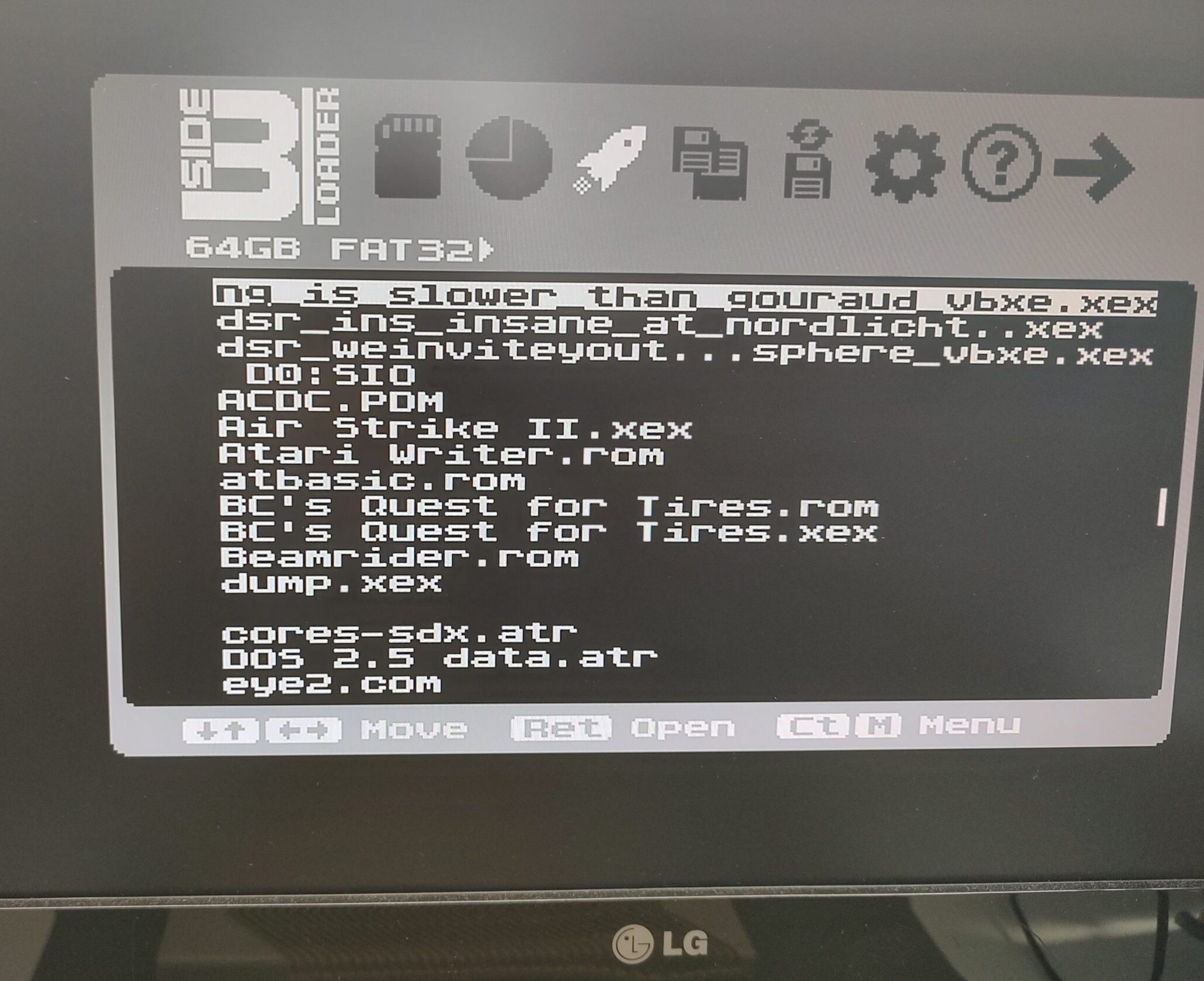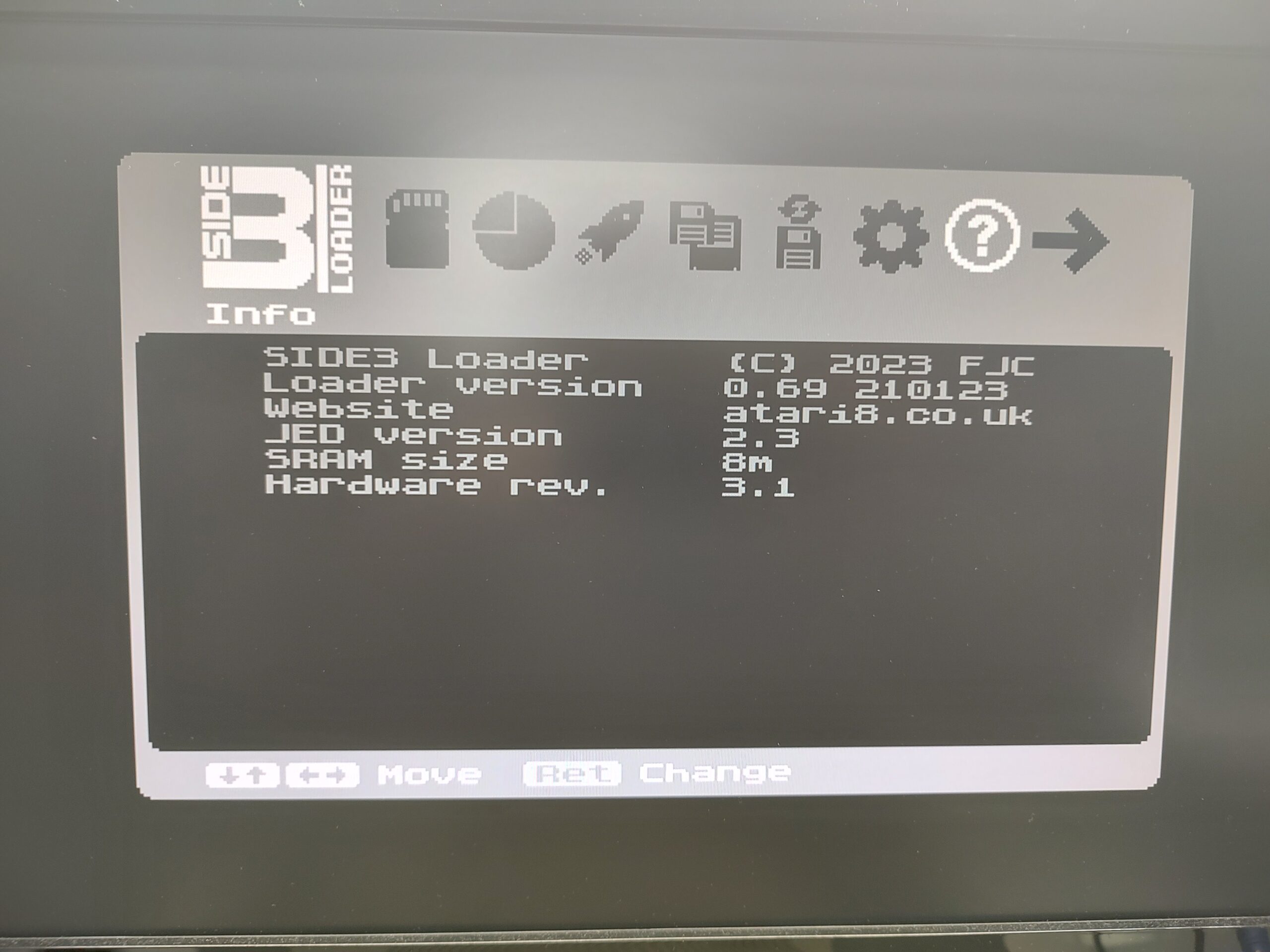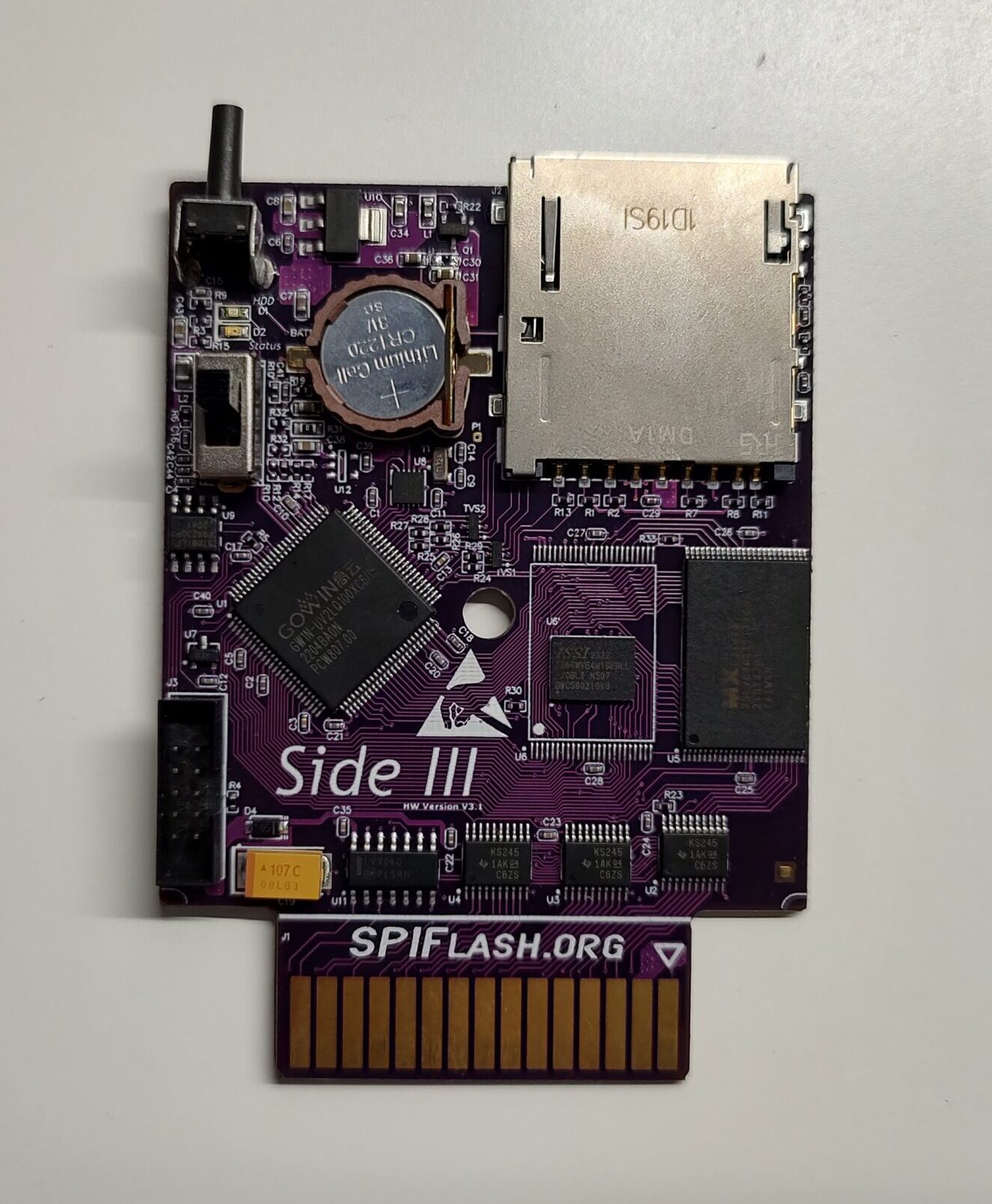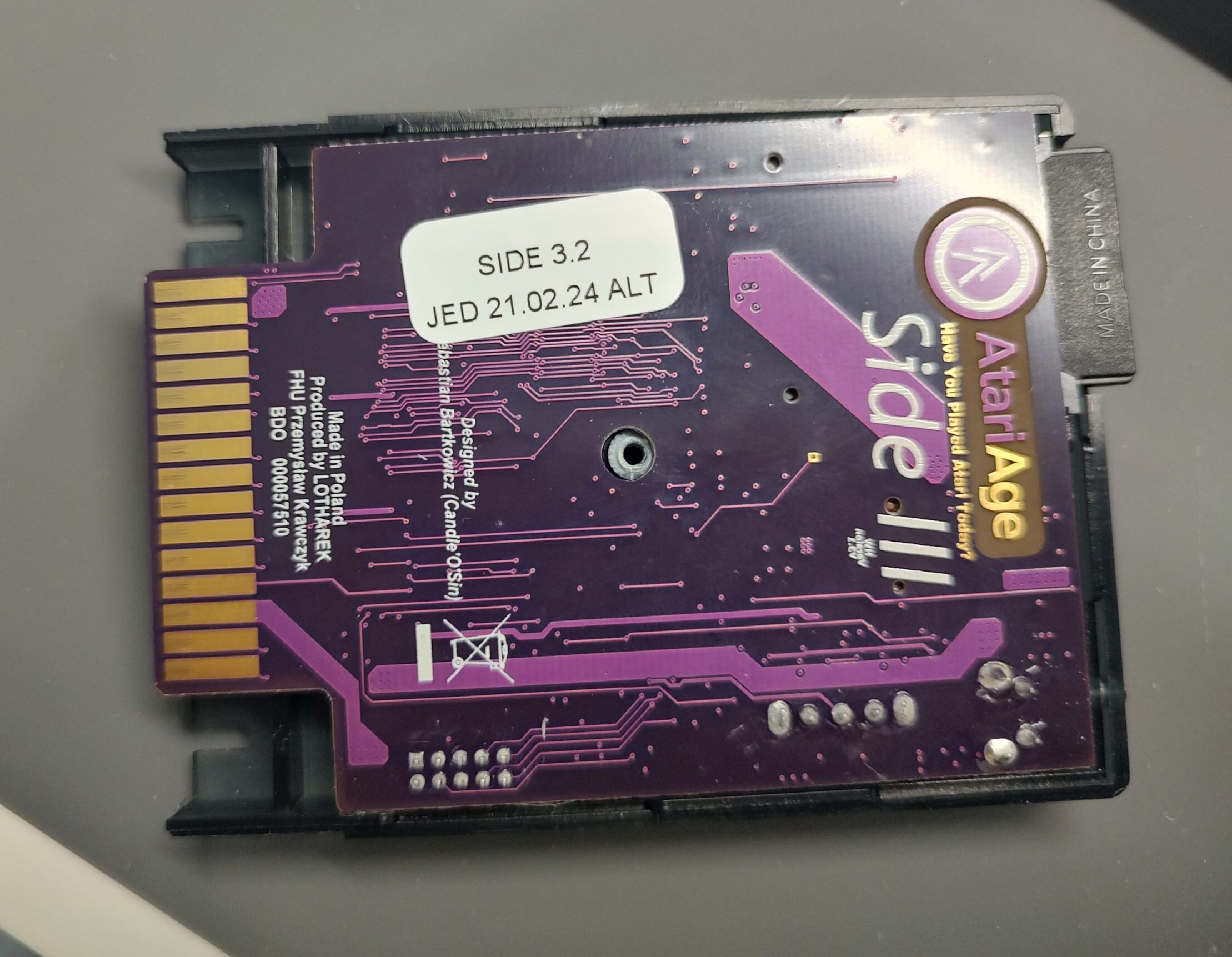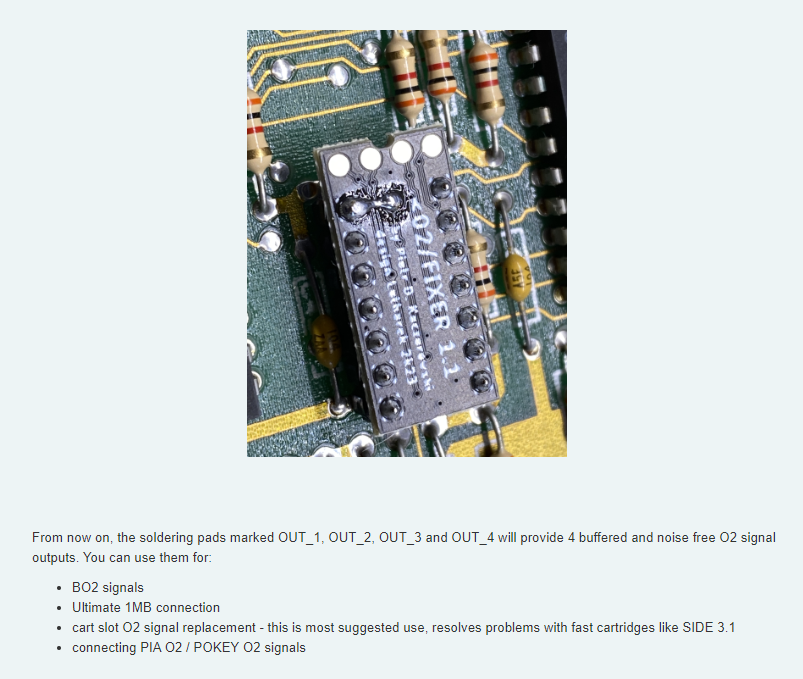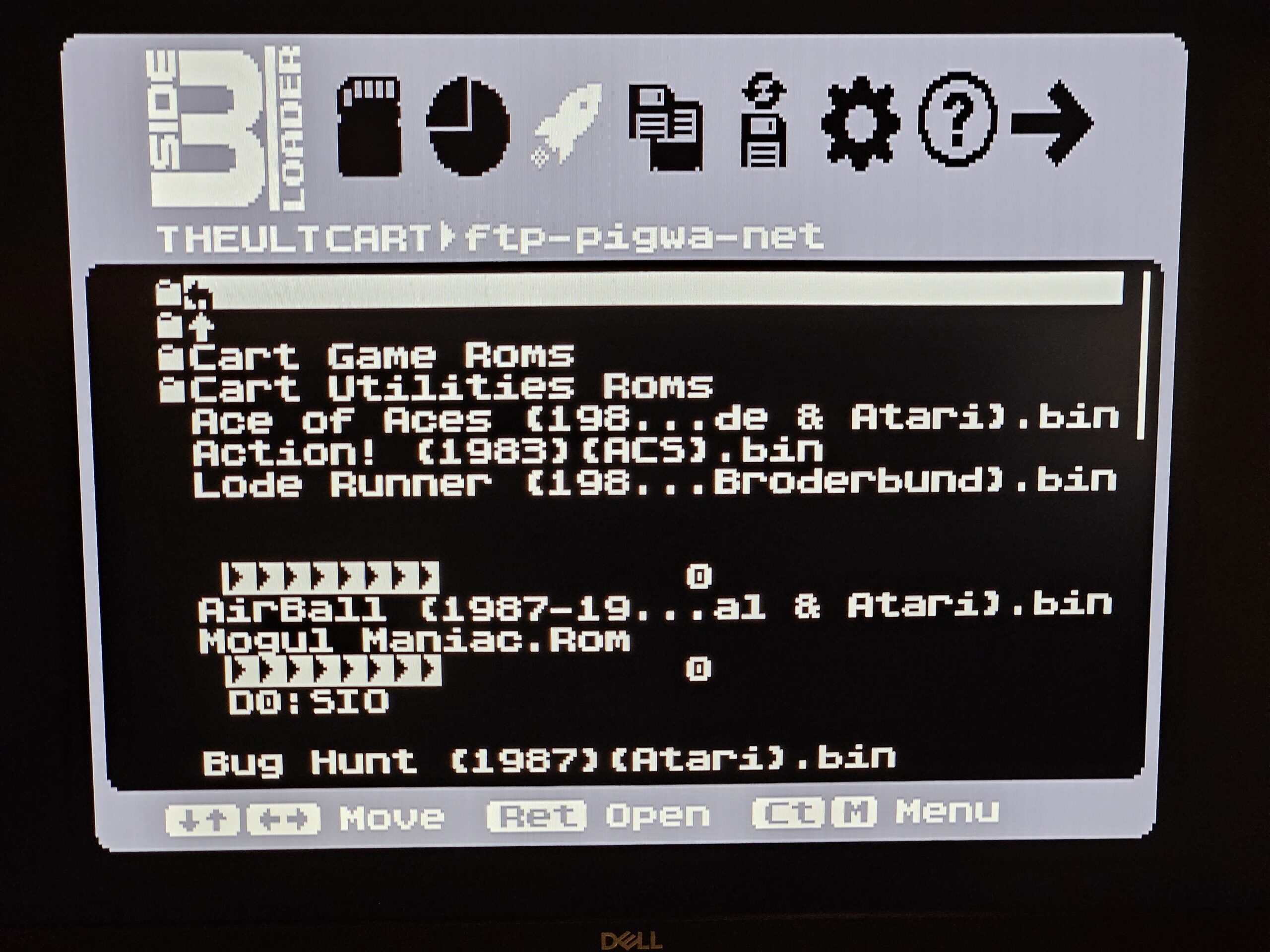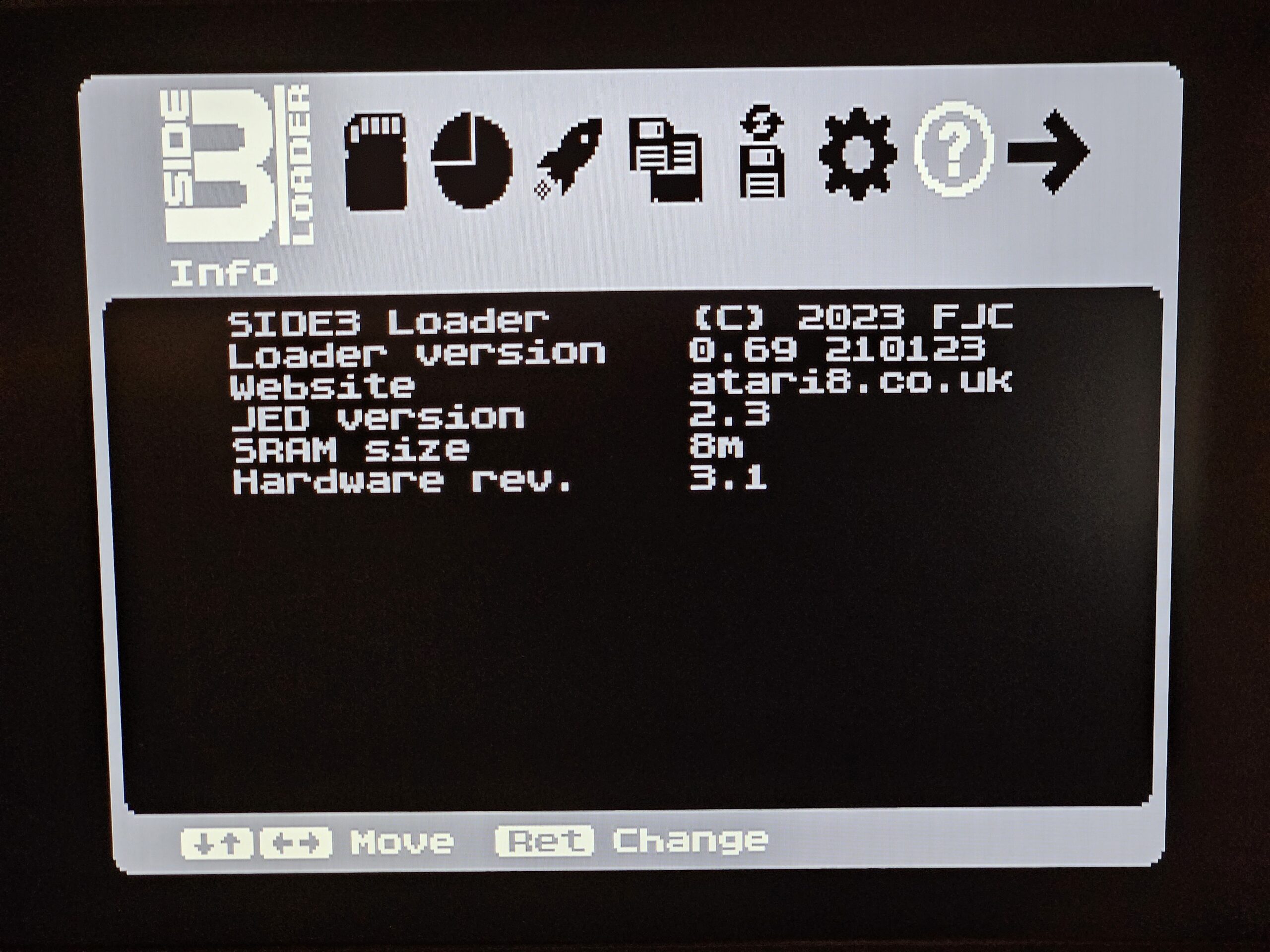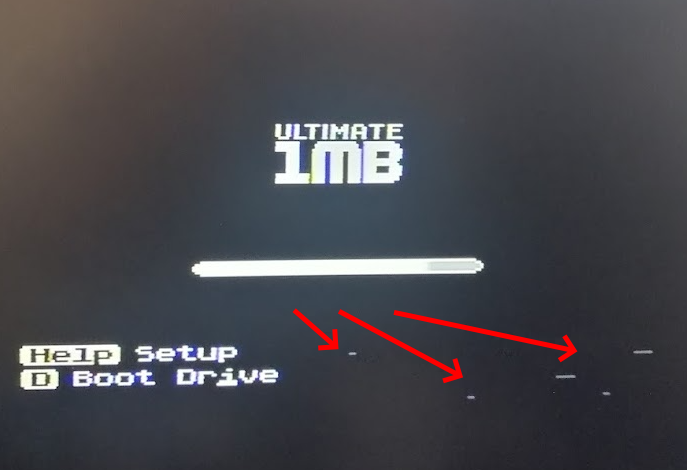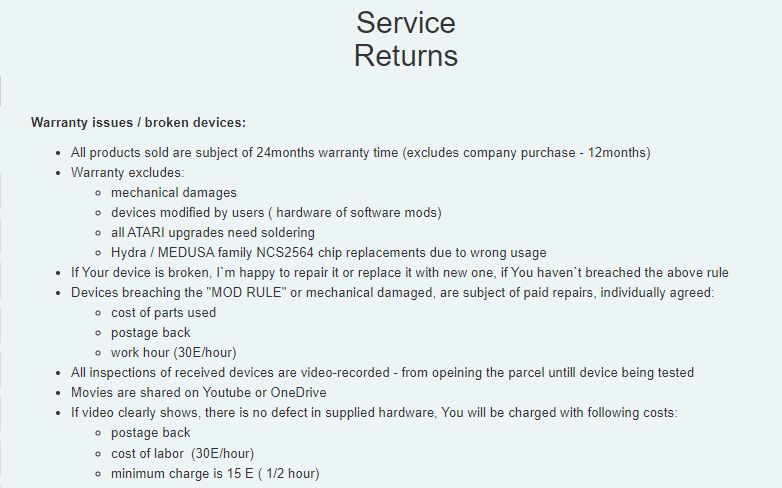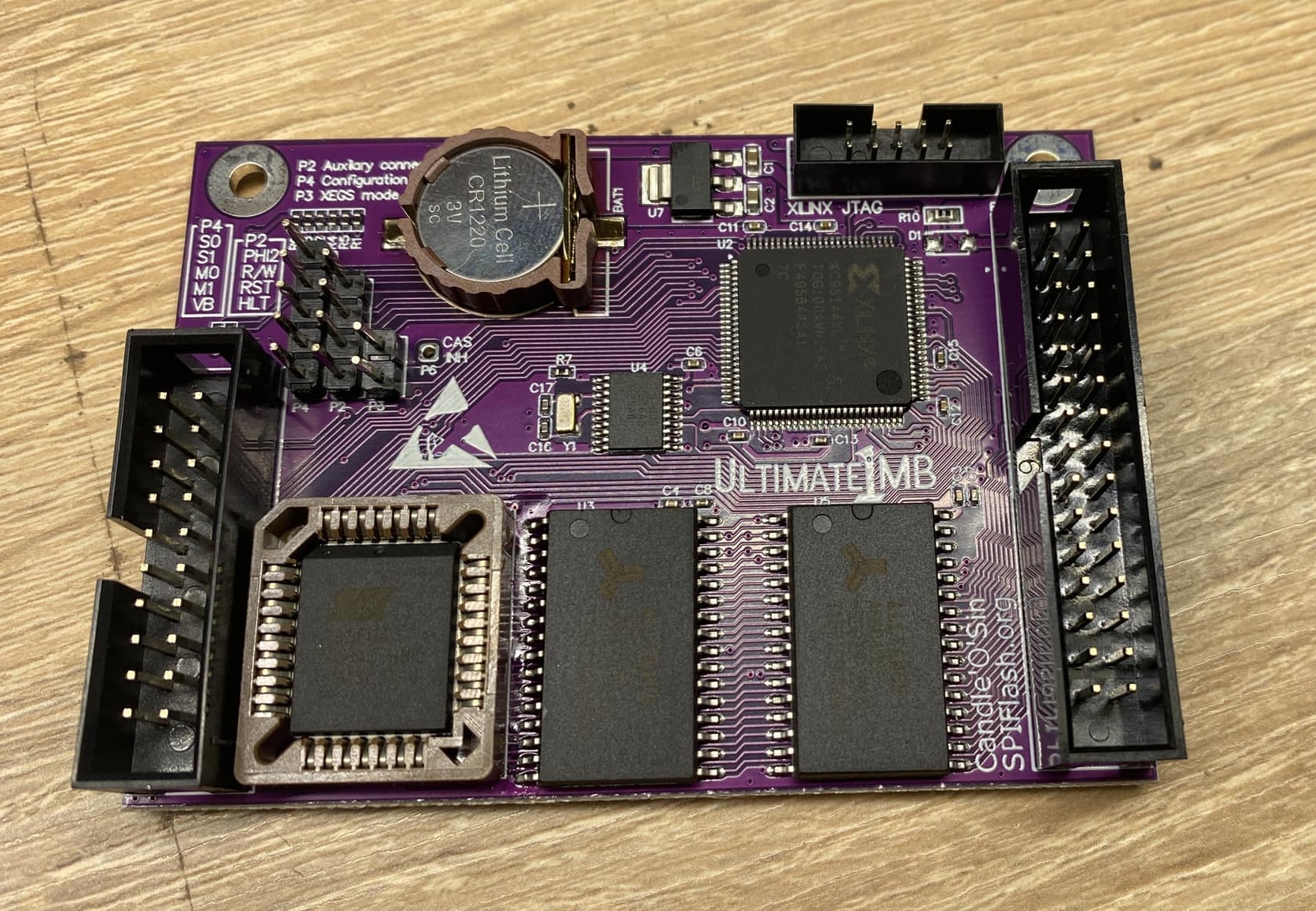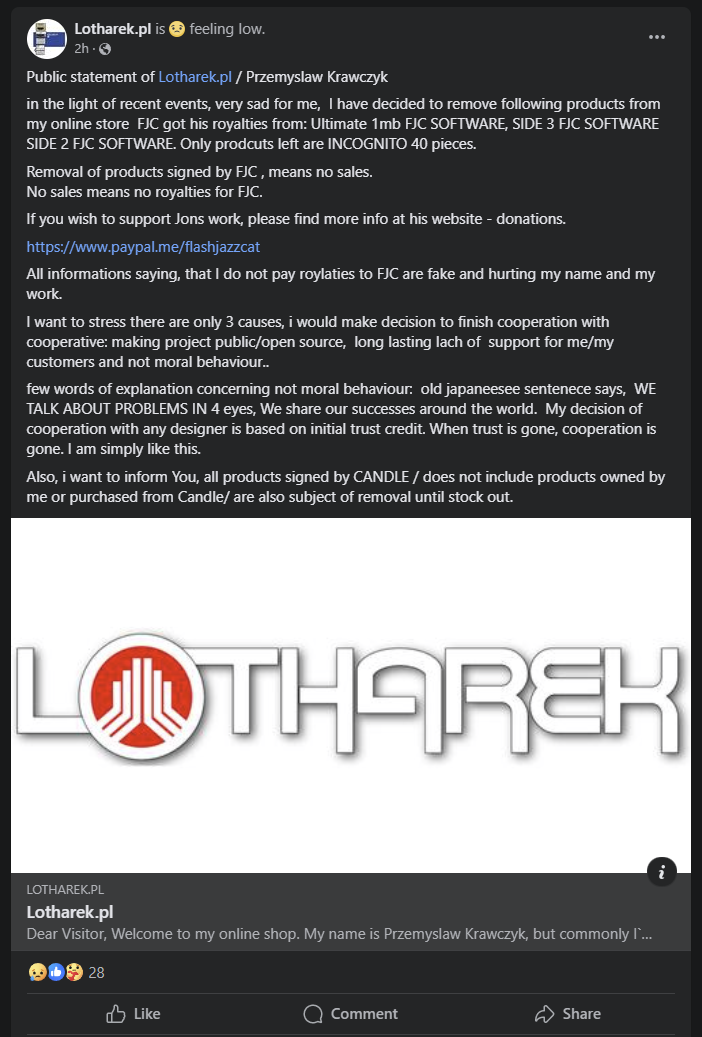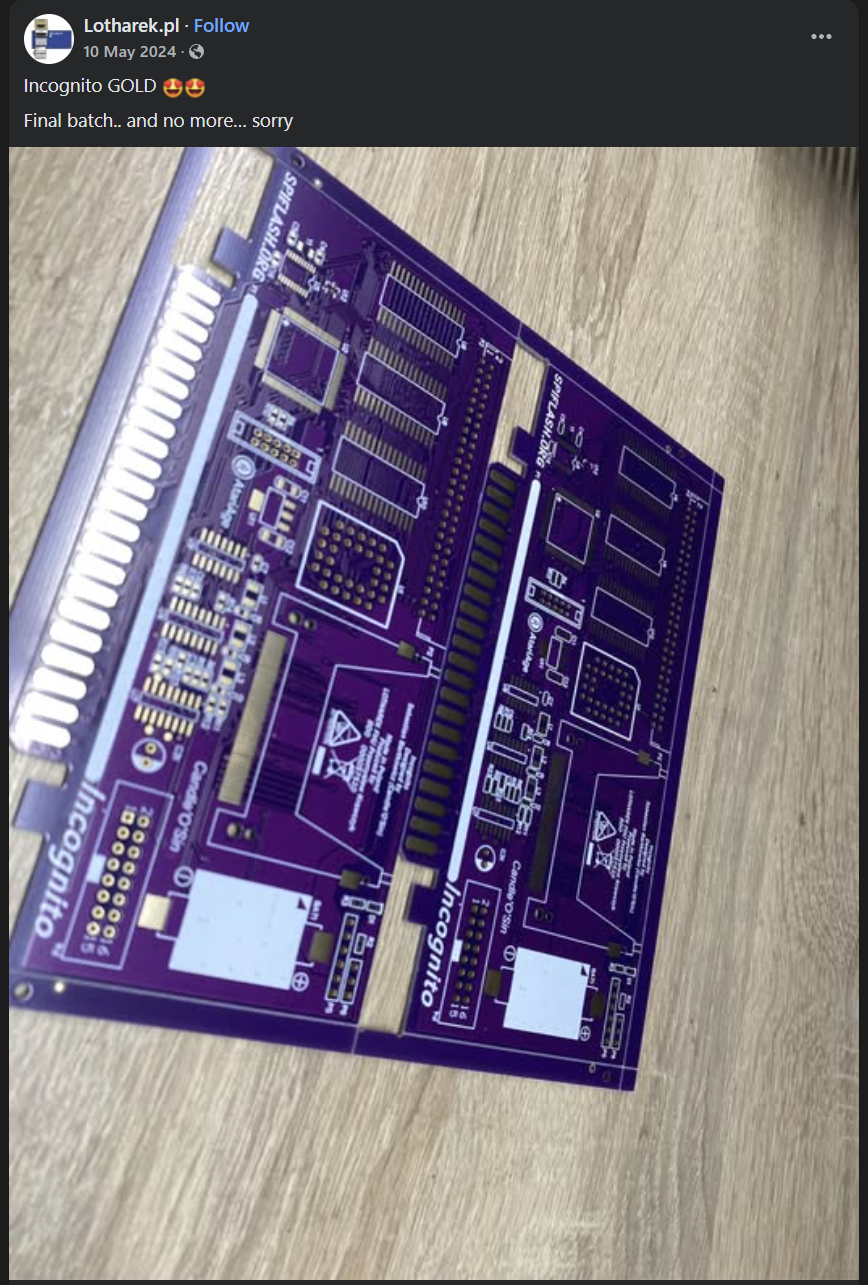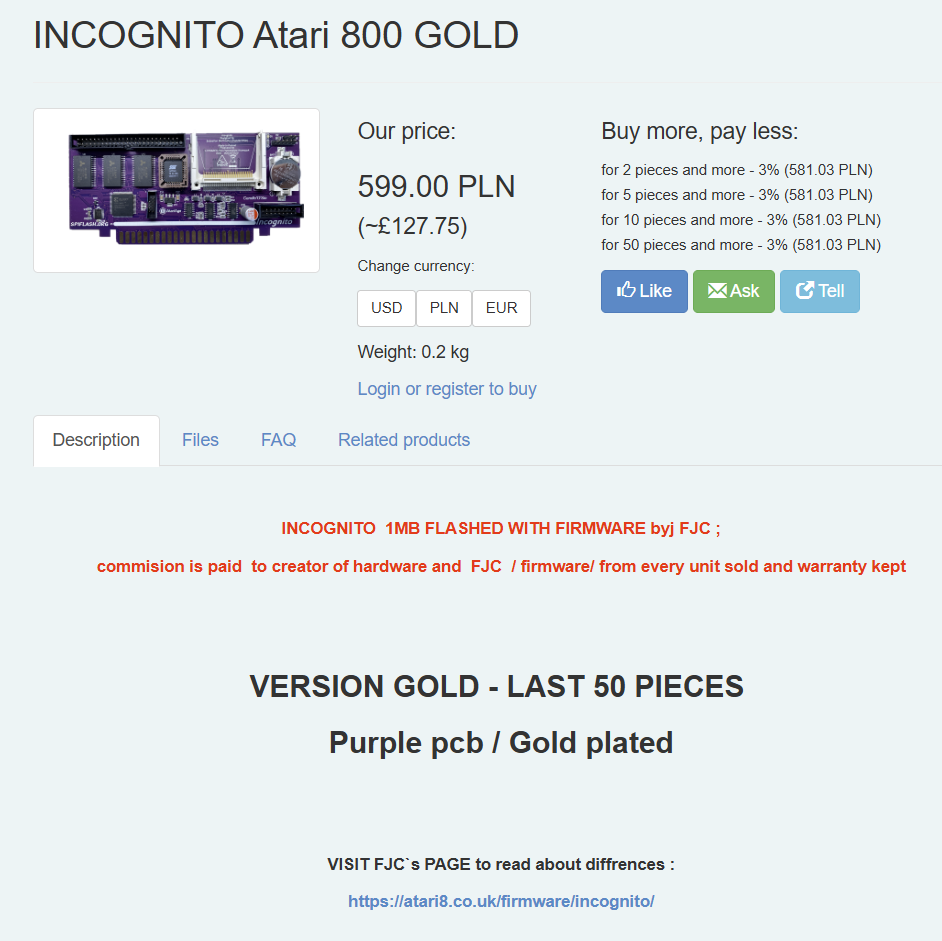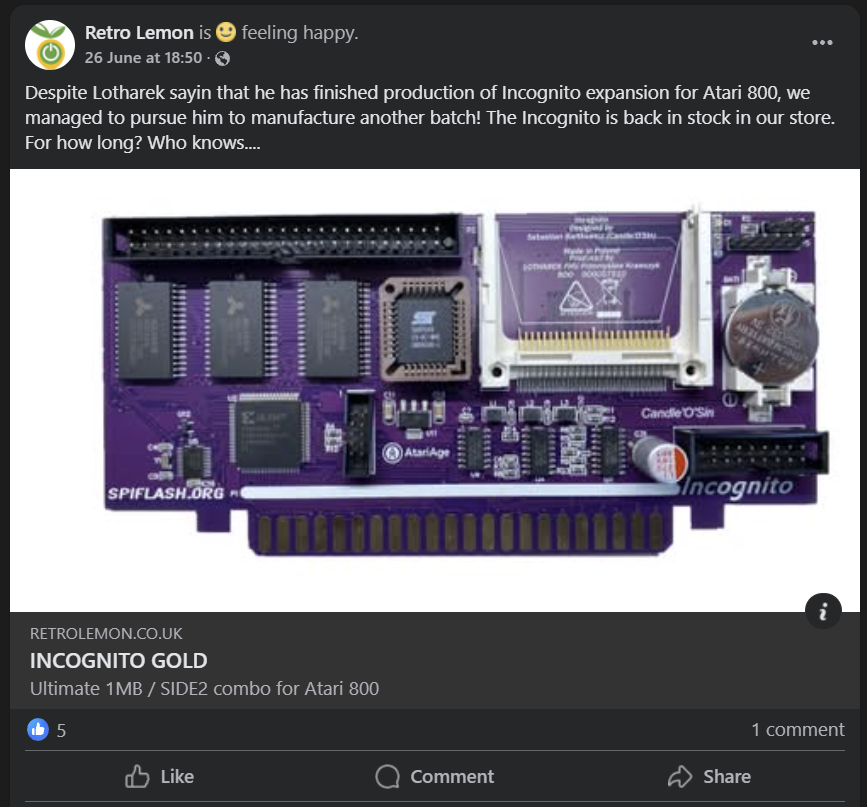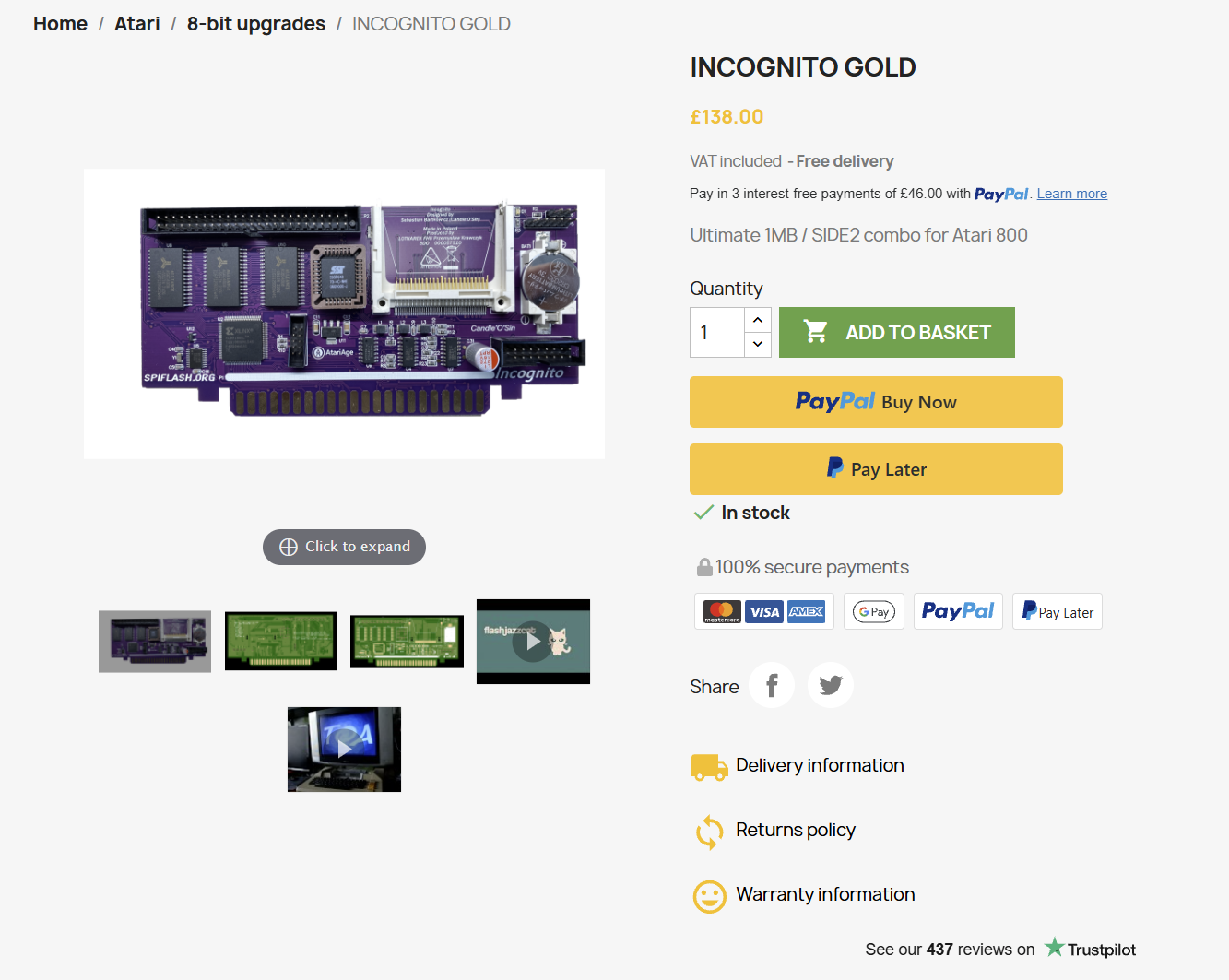In July 2024, the long-standing and mutually beneficial cooperation between Lotharek and myself came to an abrupt end. At the same time (nearly) all FJC-firmware products were summarily withdrawn from sale, and the SIDE3 cartridge was discontinued. What follows is a detailed account of the events leading up to this unfortunate state of affairs, together with an analysis of what went wrong and the lessons learned.
Contents
SIDE 3.2 and JED 2.3
Lotharek’s response to my video
‘Further action’ from Lotharek
Changes to Ultimate 1MB
Lotharek’s Public Statement
Ultimate 1MB Flash ROM Issues
Use of my U1MB firmware logo
Incognito Gold
Conclusion
SIDE 3.2 and JED 2.3
In May 2024. I received a customer’s Atari 130XE in which I was tasked with the job of installing Ultimate 1MB, Sophia 2, and UAV. Since this is typical of the upgrade assignments I receive, it did not represent a challenge and the machine was completed within a couple of days. Then – since the customer had also purchased and supplied a SIDE3 cartridge – I set about updating the Ultimate 1MB firmware with the necessary SIDE3-compatible components. While testing the system, I noticed corrupted entries in the SIDE3 Loader’s FAT directory listing, despite the fact I had pre-modded the host machine with a 74F08 chip in place of 74LS08 (unfortunately a common – but almost invariably effective – method of dealing with SIDE3 issues for the past four years).
Upon further investigation, I discovered that the customer’s SIDE3 cartridge (actually ‘SIDE 3.2’, although identifying in software as SIDE 3.1) carried a GoWin CPLD and firmware versioned 2.3. The CPLD firmware (commonly known as the ‘JED’) is the compiled VHDL bitstream which dictates the hardware behaviour and describes register locations, timing, etc. Despite the fact I already had a pre-production SIDE 3.2 cartridge (also equipped with a GoWin CPLD, which replaced the more expensive and less readily available Lattice CPLD on prior SIDE3 versions, but with different buffer ICs, indicating that the bill of materials had changed since I was sent the only supposedly representative sample of SIDE 3.2 in my possession), that cartridge had JED 1.3 installed, and until that time I had never seen or heard of JED 2.3 before. I subsequently tested my pre-production SIDE 3.2 in the customer’s machine and one of my own ‘daily-driver’ U1MB Ataris, and found it worked perfectly, while the customer’s SIDE 3.2 (with JED 2.3) would not work reliably in either computer. I then tested older SIDE3 revisions (with Lattice CPLDs carrying JED 1.1 and JED 1.3, and all with the same SIDE Loader version 0.69 present on SIDE 3.2) and likewise found that they worked correctly.
That same day – 17 May 2024 – I contacted both Candle O’Sin (the designer of SIDE3) and ‘Lotharek’ (manufacturer and vendor of SIDE3) and informed them of the problems I was experiencing, adding that it seemed highly likely that the ‘new’ JED on the customer’s cartridge was responsible for the issues. I was informed by both parties that ‘JED 2.3’ was produced to address ‘timing issues’ believed to exist on SIDE 3.2 cartridges tested by Lotharek on 19-20 February 2024. It later transpired that the testing was carried out in the wake of a customer complaint concerning the reliability of a SIDE 3.2 cartridge purchased with JED 1.3. Lotharek – testing the cartridge and finding it not to work reliably in his own test machine(s) – asked Candle O’Sin to provide a new GoWin JED revision with the aforementioned ‘tweaked timings’. The new JED – which Lotharek assumed ‘fixed the issues’ after observing it to work on his test machine – promptly (on 21 February 2024) pushed the new JED revision onto all retail boards, even posting a product recall on his website inviting customers who had purchased SIDE 3.2 prior to that date to return their cartridge so that Lotharek could retroactively update the JED.
My sole involvement at the time had been by way of the production of a ‘test’ Loader at Lotharek’s request on the morning of 19 February. Lotharek’s objective was to evaluate adjustments to the duration of the SD card power-on clocking delay in the loader to see if this would alleviate the issues he had experienced. The following day, however, Lotharek told me that a ‘hardware problem’ had caused the issues, indicating that the removal of some capacitors had provided a conclusive solution. That was the last I heard of the matter until 17 May 2024 – some three months later – when I encountered a ‘JED 2.3’ GoWin SIDE 3.2 for the first time, and found it did not work reliably on the customer’s machine (as well as directory corruption, the cartridge was prone to causing the host machine to boot directly to the OS memory test rather than to the SIDE3 Loader).
In any case, after I raised the alarm with both the designer and the vendor on 17 May, Lotharek offered to ship me a GoWin platform cable, since this would be required to downgrade the JED from version 2.3 to the (apparently perfectly functional on the customer’s machine) older version 1.3 in the absence of any ‘Wishbone’ software-flash mechanism on the GoWin CPLDs. I updated the machine’s owner on the situation, and waited for the cable to arrive.
Around four weeks later, having periodically chased up the whereabouts of the cable with Lotharek, I was told – after asking again – that it had arrived at his office. Since May’s firmware commission (the money I was paid for instances of my ‘SIDE3 Loader’ and other firmware pre-installed on devices sold by Lotharek and his resellers) was also due, I asked about that as well. Lotharek indignantly explained that he was unable to pay the commission and would be unable to post the GoWin platform cable owing to a lack of funds, and he evidently considered it unreasonable of me to expect timely payment of what he considered a trifling sum of money in the circumstances. Annoyed by this, I told Lotharek that I urgently needed the cable in order to at complete the customer’s machine and be paid my fee for the upgrade work. My last three messages on the matter (sent on 26 June 2024) apparently went unread, although £93 (representing commission on eight units) was paid into my bank the following day. The promised cable, meanwhile, never materialised.
Since it seemed unlikely I would ever receive the tools to downgrade the customer’s SIDE 3.2, Candle O’Sin suggested I might consider physically replacing the GoWin CPLD with a Lattice CPLD and thereby render the cartridge compatible with the CPLD programming tools I already had to hand. Candle provided instructions on reconfiguring the board, and I performed the CPLD swap and successfully programmed the Lattice CPLD with JED 1.3. However – for reasons unknown – the cartridge failed to work at all, despite the fact the version 3.2 PCB ‘theoretically’ supports either CPLD type (although no evidence exists that a Lattice chip had ever been installed on this board revsion prior to my unsuccessful attempt).
With the customer’s SIDE 3.2 now non-functional, I resigned myself to replacing it at my own expense and ordered another SIDE 3.2 from RetroLemon. I also ordered – on Candle O’Sin’s suggestion – a less expensive GoWin platform dongle. When the new cartridge arrived, I tested it in the same machines used for prior tests, and found it failed in the exact same way as its predecessor. However, now in possession of the platform cable, I was able to downgrade the JED to version 1.3, and when I tested it again, the cartridge worked perfectly in the test machines. Upgrading to JED 2.3 immediately ‘broke’ the cartridge again. Finally, I wrote JED 1.3 to the customer device again and pronounced the machine complete and working, more than seven weeks after I initially discovered the problems with SIDE 3.2.
From 17 May 2024 onwards I had filmed the work I did on the various SIDE 3.2 cartridges, and in July I began to edit the footage, adding to it as new developments occurred. The finished video was put on general release on YouTube on 16 July 2024.
The chief complaints the video put forward are as follows:
- Despite being the developer of the sofware/firmware for the SIDE3 cartridge, I was excluded by Lotharek from any decision-making or structured testing concerning the reliability of and/or need for JED 2.3. I had previously tested all prior JED revisions, but not only was Candle O’Sin’s direction to Lotharek that I be sent JED 2.3 and a means to flash it before it was deemed fit for release completely ignored, I was not even told of its existence, only discovering it on the customer’s SIDE 3.2 cartridge three months after it was released.
- Lotharek not only mandated the creation of JED 2.3 based on limited testing in the wake of a customer complaint, but apparently performed all pre-release beta-testing of the new JED himself and on his own machines. Moreover, said testing was carried out to completion in the space of 1-2 working days. Testing of prior JED versions – even when intended for the well-established Lattice-equipped cartridges – commonly involved several physically remote parties and was conducted over a period of weeks or even months. The possibility of other issues – be they hardware or software related – was hurriedly dismissed in favour of the conviction that the problem must lie with JED 1.3.
- To make matters worse – and despite my raising the alarm that JED 2.3 was ‘problematic’ (at least on the customer machine and my own machine) on 17 May before proving it beyond doubt some seven weeks later – Lotharek appeared determined to install JED 2.3 on recalled JED 1.3 SIDE 3.2 cartridges, regardless of the regressive behaviour of JED 2.3 which I had observed during my own tests (notwithstanding the high likelihood that the new JED would nevertheless randomly work on other machines depending on a variety of nebulous external factors, possibly including the presence of the ’64K SRAM’ board or other add-ons).
- Any progress I made concerning the customer’s SIDE 3.2 cartridge was accomplished in the face of Lotharek’s inability to provide a suitable GoWin programming cable (the one he would have provided me with in February 2024 as a matter of formaility had testing been considered a priority) at any point during the seven weeks between my identifying the problem and actually figuring out a solutuon.
In essence, my premise was that in making the executive decision that SIDE 3.2 required the stability ‘fixes’ supposedly provided by JED 2.3, and mandating that Candle O’Sin (who was apparently in no position perform first-hand testing of anything at the time) produce said JED revision, inadequately testing it (instead of sending it to me for a ‘second opinion’), and then pushing the JED onto production cartridges, Lotharek had made a catastrophic error of judgement that turned out to be a costly mistake (in terms of expense and time spent) for me and end-users alike.
Lotharek’s Response
Lotharek – upon hearing of or watching my video (which ultimately atracted over 4,000 views) – took exception to it, and engaged me directly via Whatsapp messenger. I discussed the situation with him for two hours on the evening of 17 July 2024. Although the discussion was heated, I felt things quickly became more civil, and by the end, I felt optimistic that Lotharek was keen to resolve the situation amicably (indicating to me that he would consider retroactively downgrading cartridges back to JED 1.3, or – his preferred solution – commissioning the production of yet a further new JED revision).
I was surprised, then, to discover the next morning that Lotharek had produced a video ‘statement’ concerning the ‘SIDE3 situation’, which he apparently uploaded within an hour of our conversation the previous evening. In the video, he sought – as he had done on Whatsapp and via email – to distance himself from the technical side of his products, stressing that his involvement was wholly limited to manufacture (in accordance with the Gerber files he received from Candle O’Sin, etc), retail, and first-line after-sales customer support with exclusive reference to hardware (not software or firmware).
Unfortunately, Lotharek’s insistence that he ‘just makes and sells’ the devices is inconsistent with his commissioning of JED 2.3 for SIDE 3.2 in February 2024 and of him (presumably) being the only person to undertake beta-testing of the JED before unilaterally pronouncing it reliable and fit for release. He maintains, in his video, that he ‘assumes’ the products he sells are provided in a working state by the designers and firmware authors. Yet Lotharek has for some years also offered for sale ‘fixers’ and other add-ons which explicitly claim to alleviate known, common stability issues with other products on offer – SIDE3 included.
Lotharek also states that he tested JED 2.3 prior to release (whether or not the ‘fixer’ or the 64K SRAM board he also sells were present in the test machines or not is unclear) and ‘assumed’ it fixed the problem, despite being aware that Candle O’Sin lacked the equipment necessary for scrupulous testing, and despite neglecting to enlist me (the software developer) as a (more than willing and capable) component of the structured testing.
Lotharek – in his video – also claimed that my video was the first he had heard of any issue with JED 2.3 ‘after months of silence’ (from me). This is objectively untrue, since – as stated in my video – I provided Lotharek with an unequivocal diagnosis of the problem on 17 May 2024, squarely blaming JED 2.3 for the unprecedented situation of SIDE3 being unstable on a host machine I had already attempted to make stable when used with the device. It was this communication which caused Lotharek to offer to send me a GoWin programming cable, and my frequent subsequent enquiries as to the cable’s whereabouts provided a clear indication that the JED downgrade remained a priority.
Lotharek also referenced – disapprovingly – my open-ended questions regarding the non-appearance of the SIDE3 ‘Wing’ promised and first previewed in late 2022. Said ‘Wing’ was designed to provide SIDE3 with Ultimate 1MB-like functionality such as a PBI HDD driver, extended PORTB memory, and other features requiring connection to the host machine’s ECI port. I noted in my video that the SIDE3 Loader I released in early 2023 (and which is present on all production SIDE 3.2 cartridges) even includes currently deactivated settings for the features the ‘Wing’ was envisaged to eventually provide. Lotharek blames Candle O’Sin’s ‘personal situation’ for the fact the ‘Wing’ has not yet been offered for sale, although Candle herself flatly denies this and claims that Lotharek has been provided with everything required to put the SIDE3 Wing into production (regardless of any negative effect this might have on Ultimate 1MB sales).
Throughout his video and in prior statements, Lotharek appeared to conflate my criticism of JED 2.3 and the circumstances of its deployment with criticism of his PCB production and board assembly capabilities – criticisms which were self-evidently never made (this conflation of criticism of specific devices and crticism of his business practices or reputation as a whole is a continuing theme). It was indeed Lotharek himself, when telling me on 20 February that the problems he had observed were caused by a ‘hardware problem’, who apparently considers the JED a component of the hardware – the same JED concerning which he undertook all quality control and pre-release testing, without seeking my assistance or my ‘second opinion’.
It was also interesting that Lotharek complained of ‘taking all the risk’ in the matter of manufacturing and selling SIDE3, Ultimate 1MB, etc. It should be remembered that it was:
- Lotharek who chose to purchase Candle’s hardware designs and market them exclusively
- Lotharek who decided to sell devices with my firmware installed and pay me commission
- Lotharek who decided how much my firmware was worth in terms of monthly commission
- Lotharek who eventually decided to set up his own SMT pick-and-place production facility
- Lotharek who decided to replace SIDE3’s Lattice FPGA on with a cost-reduced GoWin part
- Lotharek who decided to replace the Renesas SRAMs on the U1MB with Alliance SRAMs
- Lotharek who decided that SIDE 3.2 required a revised JED
- Lotharek who decided to release said JED without allowing me to test it first
…and so on. All this while claiming that he just ‘makes and sells’ the devices, and has no hand in their functionality or design.
‘Further Action’
While Lotharek did the arguably responsible thing and suspended sales of SIDE3 (albeit without giving me any prior private notice, and withdrawing the product not after I informed him of issues in May, but after I publicised them two months later) pending a ‘solution’, he also stated – towards the end of his video – that ‘further actions would be taken’, insinuating that these ‘further actions’ may include punitive measures such as the withdrawal from sale of all products with my ‘FJC’ firmware pre-installed (thereby denying me the firmware commission he has hitherto paid me on every device sold with my firmware pre-installed, which includes ALL SIDE3 cartridges), or even attempts to recover previously paid firmware commission on SIDE3 devices should they be returned to the manufacturer.
On 19 July – three days after my video’s publication – I discovered (again, without having received any notification) that the FJC-firmware versions of Ultimate 1MB and Incognito had been withdrawn from Lotharek’s online shop and consigned to the ‘Discontinued’ page. The FJC-firmware SIDE2 cartridge (SIDE3’s predecessor) was withdrawn shortly afterwards. The only FJC-firmware product still on sale at the time of writing is the ‘Incognito Gold’, which is a revised version of Incognito board previously sold in FJC and ‘stock’ firmware flavours (both of which have also been relegated to ‘Discontinued’ status). The ‘Incognito Gold’ is limited to a final production run of fifty units, after which no more will be produced.
On 23 July 2024, I noticed that Lotharek’s SIDE3 page had been altered yet again, the device’s status having changed from suspended/withdrawn, to discontinued/terminated.
Permanent withdrawal/termination of FJC-firmware products in this manner, in the absence of any clear rationale or explanation, seemed to me to be an act of spite, especially when considering the fact he continues to offer for sale those products (with ‘stock’ firmware) whose intellectual property he has already purchased outright from Candle O’Sin. However, since Lotharek cannot sell SIDE3 without paying commission to Candle O’Sin and to myself, and cannot sell other devices with my firmware pre-installed without paying me commission even if he owns the hardware designs outright, the only conclusion I can draw is that he simply no longer wishes to be obliged to pay commission. As of April 2025, he is still selling Incognito Gold with my firmware pre-installed (and periodically paying me my commission every time a meaningful number of devices has been sold), presumably because Incognito Gold is considered a premium offering and a limited-run collector’s edition (a fact reflected by its increased price).
As for the threat to attempt recovery of already paid commission on SIDE 3.2 cartridges returned by customers who are subsequently refunded, this appears to indicate – at the very least – that the vendor is determined to share the burden of any material loss among parties who played no part in the events which resulted in cartridges being sold with poorly tested timing tweaks. Even if it could be shown that my unambiguous and conclusive demonstration of the curative effects of removing JED 2.3 from the device were misleading and my software was somehow directly responsible for the garbled directories shown in my video, bugs in software – once discovered and understood – are easily rectified via field updates which can be quickly issued to end users and applied at zero cost and incurring minimal risk. Contrast this with the practicalities of downgrading the CPLD code on the GoWin chip; something requring the purchase of a USB GoWin platform dongle, the manufacture of an adapter cable, the installation of the GoWin platform software, and distribution of the required bitstream file to the customer. The matter appears moot, however, in the wake of email conversations Lotharek conducted with SIDE 3.2 owners in July/August 2024, in which he suggested a downgrade from JED 2.3 to JED 1.3 as a likely solution to stability issues. This – accompanied by the offer of a full refund should the customer prefer it – appears to me an unambiguous acknowledgement that problems were caused by the presence of JED 2.3. Since I had no hand in the creation of JED 2.3, no knowledge of its existence prior to its wide distribution, and was afforded no opportunity to test it prior to release, I accept no responsibility for its presence on retail SIDE 3.2 cartridges, and likewise no liability for lost income incurred through problems resulting from it.
Ultimate 1MB
The problems encountered with SIDE 3.2 closely followed some controversy concerning Ultimate 1MB, after one high-volume customer who had apparently purchased some forty U1MB boards in the space of around two years (and installed them in machines he would subsequently offer for sale on eBay) experienced SIDE3 issues when device was paired with the latest Ultimate boards he had purchased from RetroLemon. The first I heard of the matter was when Jakub (RetroLemon’s proprietor) contacted me on 8 April 2024 and asked whether I knew that new builds of U1MB had ‘compatibility problems’ with my firmware. Needless to say I knew of no such thing, and did not even know that U1MB had been revised in any way. Jakub went on to explain that Lotharek had changed the SRAM chips on U1MB after the older ICs ‘became unavailable’, and that he (Jakub) had learned of problems after the high-volume customer bought some of the newer boards, experienced issues, and noticed that the boards had Alliance SRAM chips instead of the usual Renesas memory. Problems included ‘birdies’ (ANTIC DMA corruption), malfunction of the U1MB firmware, and the machine booting directly to the OS memory test (see the ‘U1MB Flash ROM Issues’ section later in this article).
My chief objection to the diagnosis put forward (that the issue – although acknowledged to be caused by hardware changes rather than software – manifested itself only when my firmware was present) was that the supposed correlation between the firmware version and manifestation of the issues. My contention was that if memory corruption and DMA issues were occuring in the wake of the hardware changes, they were happening regardless of whether the firmware installed on the board made such issues easier to observe. In short: the hardware either worked or it didn’t.
I contacted Lotharek directly regarding the issue, and he responded – interestingly – by saying that he was unprepared to offer support to the customer who had reported the issues, on the grounds that he refused to support people who would not pay for my work (i.e. the firmware). It was clear that Lotharek knew that the customer was purchasing U1MB in large volumes, and that he was purchasing the boards in ‘stock’ configuration and applying my firmware after the fact. What Lotharek did not realise, however, was that the customer was making regular firmware payments of GBP 20 per unit sold, thereby bypassing Lotharek (who charges a ~GBP 20 premium on the FJC-firmware devices, resulting in commission of ~GBP 11.50 paid to me per sale). So in actuality, the customer was offering me more generous material support than the vendor. Indeed, any end-user was operating fully within their rights when purchasing a ‘stock’ device and upgrading it with my firmware after the fact, regardless of whether they chose to offer me material compensation for my work or not. What I had stipulated in the terms of use was that commercial sellers should make prior licensing arrangements with me prior to selling instances of my firmware pre-flashed to retail hardware. The customer – whether morally obliged to make such payments or not – had chosen to do so (presumably because of the volume of machines he was upgrading and selling, and out of a genuine desire to support my efforts regardless of volumes sold), thereby – in my view – making himself immune to criticism of any kind from any direction.
It seemed to me, however, that Lotharek – realising the vendor had been denied an albeit small amount of revenue and that the customer was paying me almost double my usual commission intead of spending the balance on the premium charged for the FJC devices – was quite irked by being ‘cut out of the deal’, despite initially appearing to take a principled stance on the need for me to be compensated for my contributions. Lotharek also stressed that the customer support issue was Jakub’s problem and not his, and that he wasn’t directly involved in the activities of his resellers.
The customer – with whom I had liaised directly in the wake of Jakub’s remarks – subsequently sent me two of the ‘problematic’ U1MB boards so that I could test them. Although I was unable to replicate his issues, I did notice several other board-routing changes to the device in addition to the Alliance SRAMs already known about, and the slightly unusual PLCC flash ROM markings the customer had also reported. The customer kindly allowed me to keep one of the two revised U1MB boards, and I later noticed that the board donated to me had two cuts on the 5V trace from the OS ROM connector, and a diode ‘bodged’ to the front of the board.
Subsequent discussion with Candle O’Sin revealed that the modifications were intended to alleviate perceived Alliance SRAM incompatibility with NMOS TTL signals by lowering the operating voltage of the RAM chips. I was, however, unable to observe any behavioural difference between the modified board and another Alliance-SRAM-equipped U1MB I received (which lacked the cut traces and the diode) from a customer.
As a result of these changes and the uncertainty they caused, the high-volume customer lost confidence in purchasing ‘stock’ U1MB boards and upgrading them after the fact, especially given the UK vendor’s puzzling assertion at the time that the Alliance-SRAM U1MB boards were only guaranteed to work with the stock firmware. The customer thereby felt obliged (in order to ensure he was protected by the product warranty) to purchase devices with the FJC firmware pre-installed, and in so doing pay the FJC-firmware premium to the vendor and support my efforts indirectly rather than directly. The customer also remarked that the terms of the warranty implied that stock boards subject to ‘software mods’ (i.e. after-the-fact firmware updates) might not be covered by said warranty.
Regardless, this situation represented another instance of my being ‘kept out of the loop’ and encountering and/or being implicated in issues caused by changes made without my knowledge. Not only that, but it was another example of customers ending up in the potential position of beta-testing changes to hardware which they knew nothing about when they purchased the device. Moreover, the attitude of both the manufacturer and the vendor indicated a strong desire to steer customers into paying the premium price for devices with the FJC firmware pre-installed instead of purchasing the stock firmware device and updating the firmware after the fact. Indeed, the warranty policy offers further discouragement to any end-user interested in proceeding in that manner, by suggesting that the warranty (which is ‘kept’ on the pre-upgraded devices) is invalidated once the user upgrades the firmware on the device.
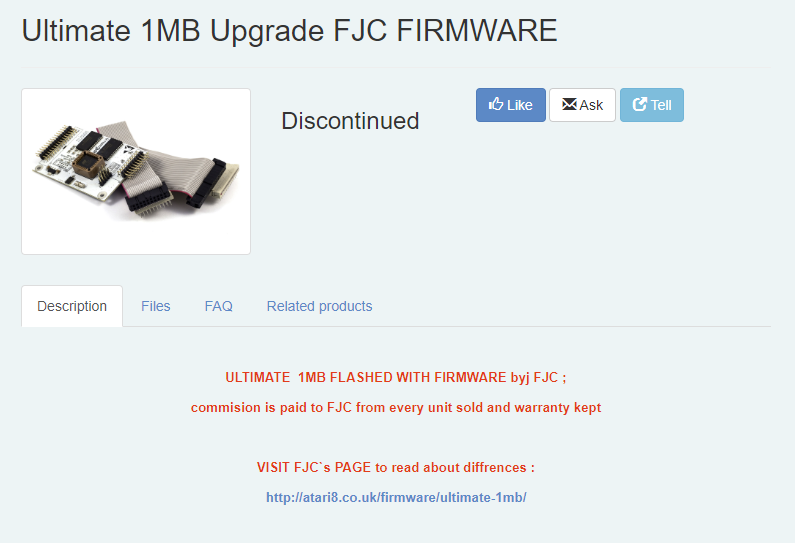
Indication that the warranty – ‘kept’ with pre-upgraded devices – is not kept with user-upgraded devices
Ironically, U1MB with my firmware pre-installed has since been withdrawn from Lotharek’s product line, and Lotharek has perfunctorily indicated (in a video) that users might instead offer me their support independently. The net result is that potential users of my firmware are no longer covered by any product warranty after applying after-the-fact firmware updates.
On 8 May 2024, Lotharek posted on his social media business page images of ‘U1MB Revised 2K24’ being tested. Although Candle had previously indicated to me that a revised board would eventually be released (primarily in order to better accomodate the Alliance SRAMs and get rid of the large CR2032 coin-bell battery previously mounted on the bottom of the PCB), I have at the time of writing received no pre-production or production sample. As of February/March 2025, the revised board (now renamed ‘U1MB Revised 2K25’) is apparently being sold in place of the older stock.
As of April 2025, it is notable that the product page of the ‘U1MB Revised 2K25’ includes an oblique reference to ‘fixes’ in the ‘current’ (now prior) version of the board whose successor is now ‘100% safe and sound’. Presumably the ‘fixes’ refer to the Alliance SRAM and diode ‘bodge’ present on the previous board revision, the implication being that the vendor acknowledges that things were – at some point – not ‘100% safe and sound’.
At the time of writing, it is unclear which brand of SRAM is provided on ‘U1MB Revised 2K25’, boards being pictured with both Alliance and Renesas SRAMs (although ‘D1’ appears unpopulated regardless of which SRAM is installed). The author has not at the time of writing yet received a board for the purpose of evaluation, review or installation.
Lotharek’s Public Statement
On 4 August 2024, Lotharek published a statement on his ‘lotharek.pl’ Facebook business page, saying that:
- He had decided to remove all FJC-firmware products from his shop (aside from the remaining ‘Incognito Gold’ boards, of which he claimed forty of the original fifty units remained unsold).
- Accusations that he did not pay FJC royalties were ‘fake’ and damaging to his reputation.
- His decision was motivated by ‘open-sourcing’ of projects, ‘lack of support’, and ‘not moral behaviour’ [sic].
- Problems should be discussed in private, while successes should be publicised.
- He would also withdraw from sale all ‘Candle’ products whose IP had not already been purchased outright.
The statement was subject to at least one series of revisions, and the final version included a link to my PayPal donation page and an invitation to ‘support Jon’s work’.
While this statement broadly did no more than confirm a course of action which could already be inferred from the content of his video and the edits made to his website in late July, editorialising concerning non-payment of ‘FJC royalties’, ‘lack of support’ and attempts to adopt a position of moral superiority were puzzling to say the least. Responding to one commentator, Lotharek claimed to have received no prior correspondence from me at all regarding problems with SIDE3 JED 2.3.
However, this represents a ‘lie by omission’, since he failed to mention the WhatsApp messages I sent in May and June (the first – sent on 17 May – being illustrated earlier in this article), all of which were read and acknowledged, but which failed to elicit a practical solution. Not only was Lotharek therefore made aware of the issue via ‘the usual’ channel on 17 May, but the questions concerning the ‘morality’ of my video concerning JED 2.3 are inapplicable, every reasonable attempt having been made to motivate Lotharek into action up to seven weeks before my video was published (communications having eventually tailed off after five weeks following a quarrel regarding overdue firmware royalty payments and the non-appearance of the GoWin platform cable I had been promised).
Moreover, the clear sentiment that ‘problems should remain private, while successes should be made public’ raises some concerning questions regarding transparency in the eyes of the customer. By 17 May, SIDE 3.2 with JED 2.3 had been on sale for almost three months, and during the ensuing seven week period (until my video was published), I am aware of no attempts made by the vendor to a) correct the issues or b) notify customers there might be a problem. Indeed, his earlier RMA notification invited customers who had purchased SIDE 3.2 with JED 1.3 prior to 21 February to return their cartridge and have it ‘upgraded’ to the problematic version. It remains questionable, then – had my video (which simply confirmed the diagnosis I had privately provided on May 17) not been published – whether JED 2.3 owners would have been made aware of any potential reliability issues at all.
Concerning ‘lack of support’: it’s difficult to know what more I could do in terms of supporting the manufacturer, having promptly provided the requested test loader on 19 February within an hour of Lotharek requesting it, and having provided a report (sent directly to Lotharek) of the JED 2.3 problems on 17 May within an hour of discovering them (and later confirming the cause of the issue using equipment purchased at my own expense).
Regarding royalties, the source of accusations of ‘non-payment’ are unknown. At no point in my video was there any direct or implied accusation that commission had been persistently withheld. What I did reference was that payments had progressively arrived later and later every month up until June’s in-arrears payment for May (which arrived unprecedentedly late, on 26 June), but I deliberately avoided going into detail concerning the explanation privately offered for the lateness of May’s royalty payment. I also presented my actual income received per unit as a porportion of the surcharge imposed on the customer (being unaware that any secrecy or non-disclosure agreement surrounded this sum) and did so ‘without comment’, being perfectly satisfied with the percentage I received per sale.
On 5 August – the morning after posting his statement and apparently in light of commentary provided by me and other observers – Lotharek appeared to conclude the discussion by blaming communication issues on the presence of ‘Candle in the middle’.
U1MB Flash ROM Issues
In February 2025, I received a machine from a customer who wanted me to install Ultimate 1MB and VBXE in an Atari 800XL which he sent along with both internal upgrades (which he had purchased from RetroLemon). When I tested the machine after installing the upgrades, I found that the computer persistently booted directly to the OS memory-test and indicated a ROM fault. Needless to say this meant the machine was in no fit state to be sent back to the client, so I set about troubleshooting the issue and eventually discovered that the SST branded PLCC flash ROM in the customer’s brand new U1MB board was responsible for the problem. When I swapped the flash ROM out for another SST part (from a spare U1MB board), the issue disappeared. Moreover, the primary issue followed the original flash ROM chip around when I tried it in spare, known working Ultimate 1MB boards.
Interestingly, the issue exhibited identical symptoms to those reported by the aforementioned eBay seller and high-volume buyer of U1MB when he first encountered boards equipped with Alliance SRAMs almost a year earlier. He had also drawn attention to the markings on the PLCC flash ROMs at the time, but no definite correlation could be found between the use of industrial and consumer ICs and the presence of any operational issues.
I immediately informed Jakub at RetroLemon of the issue (although there was no need for an RMA since I had solved the issue by replacing the flash ROM at my own expense, I thought it prudent to inform the vendor of the matter so that he could feed back the information to the board’s manufacturer). Jakub acknowledged the issue but said that since boards with the black PCB and diode bodge had all sold out and were to be replaced with the ‘Ultimate Revised 2K25’ going forward, he hoped that ‘the purple boards will be better’.
Having filmed the work on the client’s machine, I published a video documenting the troubleshooting process.
Reimaged 800XL motherboard and U1MB firmware logo
On March 31 2025, I noticed an AtariAge forum post publicising a new design announced on Lotharek’s social media page. The post included illustrations of a reproduction Atari 800XL motherboard with an integrated Ultimate 1MB, and overlaid in the location of the U1MB was a copy of the firmware logo from my U1MB firmware (the firmware which Lotharek decided to stop selling pre-installed on the boards back in July the previous year).
Since Lotharek had used the logo (which is my own design) without permission, I remarked in the forum thread that it ‘would have been nice if he’d asked permission first’, and on the social media post itself, I posted a comment requesting that he remove the logo from the image.
Meanwhile, another AtariAge forum member humorously observed that I probably wouldn’t be providing the U1MB firmware for Lotharek’s new board. I agreed, adding that – by my calculations – I was still due payment for the remaining stock of ‘Incognito Gold’ boards (which were still being sold with my firmware pre-installed). Since the most recent firmware commission payment at the time was received in November 2024 for October 2024’s sales (pending eventual ‘stock out’ status on all the discontinued lines), it seemed plausible that further units had sold in the intervening time and that further monies may conceivably be due. No correspondence whatsoever had been received from Lotharek in that intervening period, despite the fact he would previously notify me by email on a monthly basis even if only to inform me that no payments were due. Indeed, the last contact had occurred on 15 December 2024, when I had emailed Lotharek asking for the breakdown of the last payment received (information which had previously been supplied with every payment, but which had been missing from the 13 November payment) for my own records.
In any case, an hour after I made that remark in the forum thread, Lotharek made the following indignant post (shown with my reply below):
Seemingly, he believed I was under the impression that Jakub of RetroLemon was somehow involved in the commission payment process (i.e. that customer sales at RetroLemon would trigger commission payments). This is not the case, and I fully appreciate the fact that firmware commission becomes due when RetroLemon raises a stock order, and that such commission forms part of the payments made directly to me by Lotharek (to cover his private sales and sales to resellers).
Shortly afterwards, I received the following email from Lotharek, which included data showing that eight Incognito Golds had been sold in the five month period between 1 November 2024 and 31 March 2025. The body of the message requested that I ‘remove all informations [sic] [I] made in public that may implict [sic] in bad way on LOTHAREK company’.
Since the data provided seemed to corroborate the observation that I was ‘owed money for Incognito Gold firmware’ (regardless of the dates presented in Lotharek’s forum post or Jakub’s claim that the five units he purchased had only been ordered a fortnight earlier), I replied as follows:
Needless to say, I do not expect to be making any corrections or retractions, not having written or otherwise stated anything known to be factually inaccurate. At the time of writing, Lotharek has not responded to the invitation to demonstrate the factual inaccuracy of any statments made.
The following day, I noticed that Lotharek had removed my U1MB firmware logo from the motherboard illustration on his social media page, replacing the design with the generic U1MB logo, the rights of which he owns.
I’d like to extend my thanks to Lotharek for making the correction.
A few days after the events surrounding the firmware logo, Lotharek sent me payment for fourteen firmware licenses.
Incognito Gold
On 10 May 2024, Lotharek indicated on his social media page that he would be manufacturing one ‘final batch’ of the highly acclaimed ‘Incognito’ personality board and RAM upgrade for the Atari 800.
Incognito had hitherto been sold in both stock and ‘FJC’ firmware flavours, but for the final production run, Lotharek switched to a purple PCB design which would be sold only with my firmware pre-installed and marketed as ‘Incognito Gold’. Given that only fifty boards would be produced and that the price was some 20 per cent higher than that of the prior ‘FJC firmware’ Incognito, it seemed clear that the device was positioned as a ‘limited edition’ product.
Since Lotharek explained in March 2025 that very few Incognito Gold boards remained to be sold, one naturally expected that the last of the fifty boards which comprised the final run would be sold shortly thereafter. However – the product page never having indicated that the Incognito Gold had ‘sold out’ – I was surprised in June 2025 to notice the announcement of a second run of Incognito Gold boards.
Naturally this came as a surprise not only to me, but to a few other observers, especially given the ‘last chance to buy’ context in which the prior run was produced. Naturally one does not object to the opportunity to earn further firmware commission (the first instalment of which Lotharek undertook to pay shortly after the second run was announced), and if the final opportunity to own an Incognito ends up existing in perpetuity, it must surely represent a reliable revenue stream for the manufactuer and vendors alike.
Conclusion
It’s disapponting to no longer be involved in the development and testing of what were once class-leading devices, and unfortunate that the development work I had started in July 2024 on further improvements to the SIDE3 Loader no longer justifies further effort, the commercial variant of the device having been discontinued, and with it any determinate source of compensation for the considerable amount of development work required. Since I began work on the replacement U1MB firmware back in 2015 and worked on the SIDE3 firmware from 2019 onwards, I undertook a firmware development cycle spanning almost a decade of my life and to the exclusion of most other ongoing software projects. While this undertaking certainly – ultimately – generated revenue, it was also intended to be an investment in future projects, none of which – it seems – will now reach fruition, and certainly not in a commercially viable setting.
As I see it, the videos on my channel provided positive publicity and free advertising of the devices in question, and when the installation and end-user experience was positive, everyone was happy. The content and the firmware I had created made the devices more desirable and drove sales. However, when installation videos (which form the bulk of my content) began to feature operational issues caused by insufficiently tested hardware and firmware changes, they became problematic from the point of view of the vendor. Although the last thing I wanted to do was present a regressive picture of the devices under discussion, I also felt obliged to represent the actual situation rather than an idealised version of the user experience. As well as the problems themselves, I also documented the solutions where solutions were provided. However, it has often been the case that no solution was offered at all, and in the case of SIDE 3.2, six weeks of intermittent private discussion with the vendor concerning the operational issues I had encountered while carrying out paid installation work resulted in no serious effort to address the situation until I reluctantly publicised the problems in a video.
Should I become involved with the development of firmware for actively developed hardware again in the future, I think the lessons learned from my experiences working on SIDE3 will prove invaluable. At the bare minimum, a project of this magnitude and complexity requires effective project management, clear communication, centralised resource management which ensures that all involved parties are automatically notified of (and sign off on) all hardware, firmware and software changes, and structured in-house and public beta testing strategies. The responsibility for success or failure in such a scenario would thereby be equally shared among all parties involved.
FJC
(Last revised 10 July 2025)

